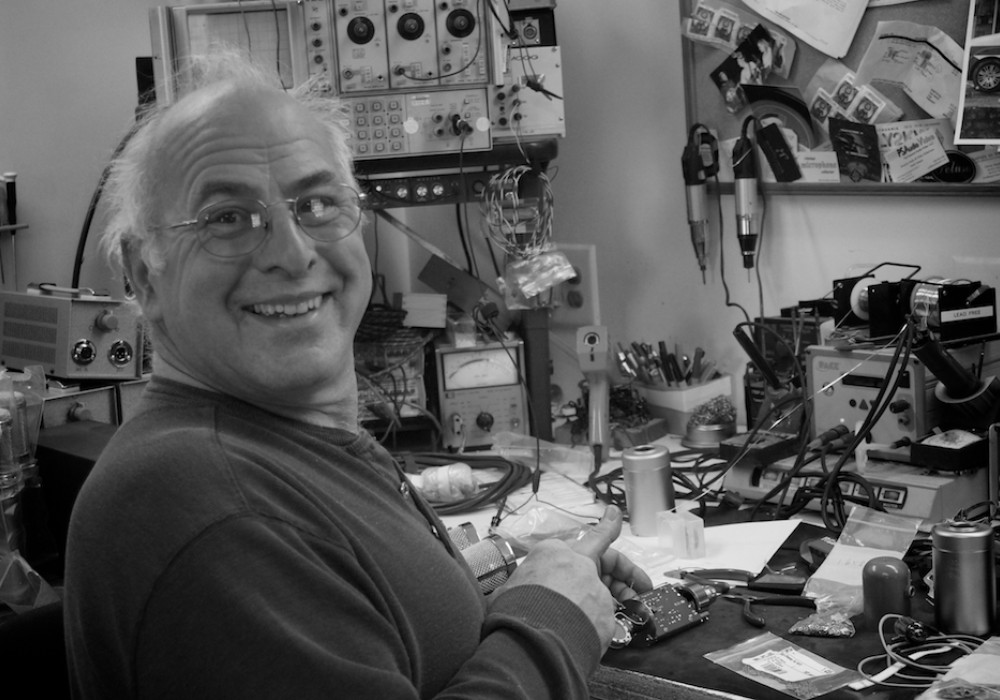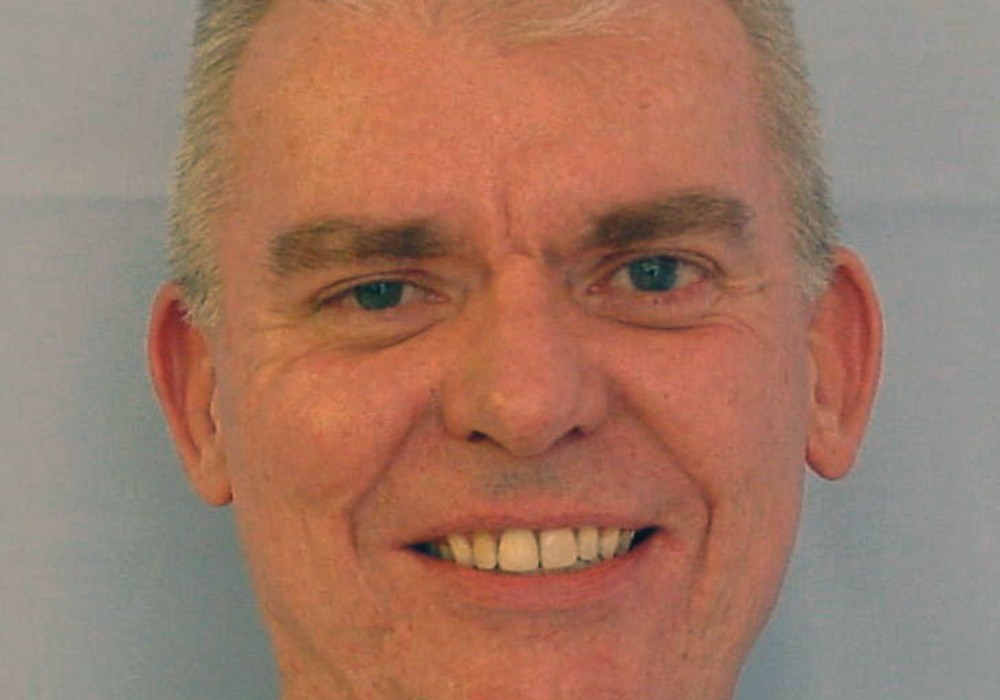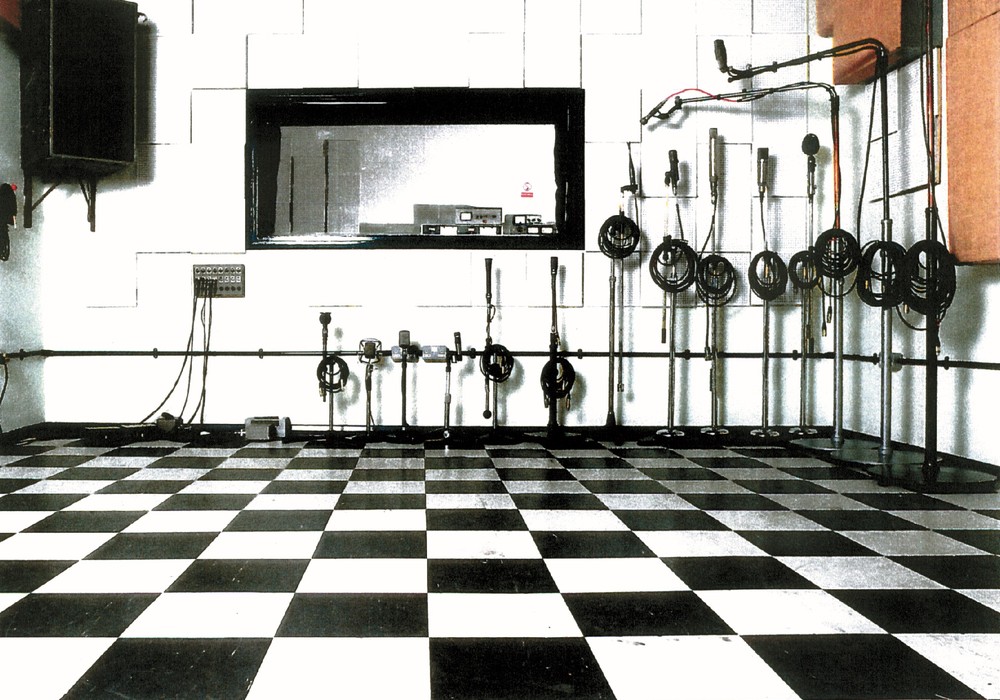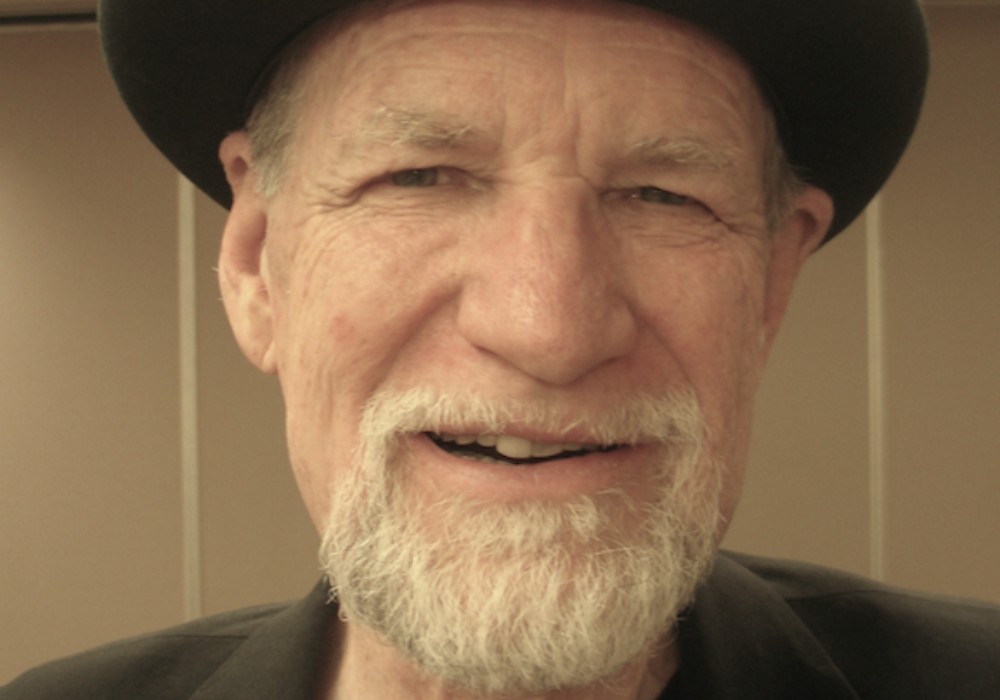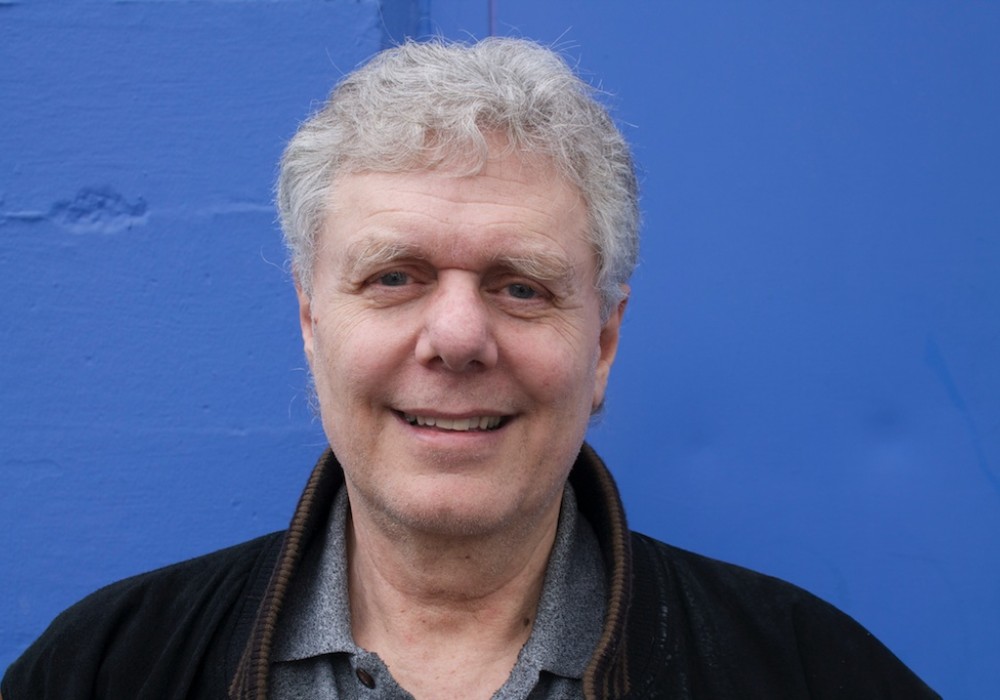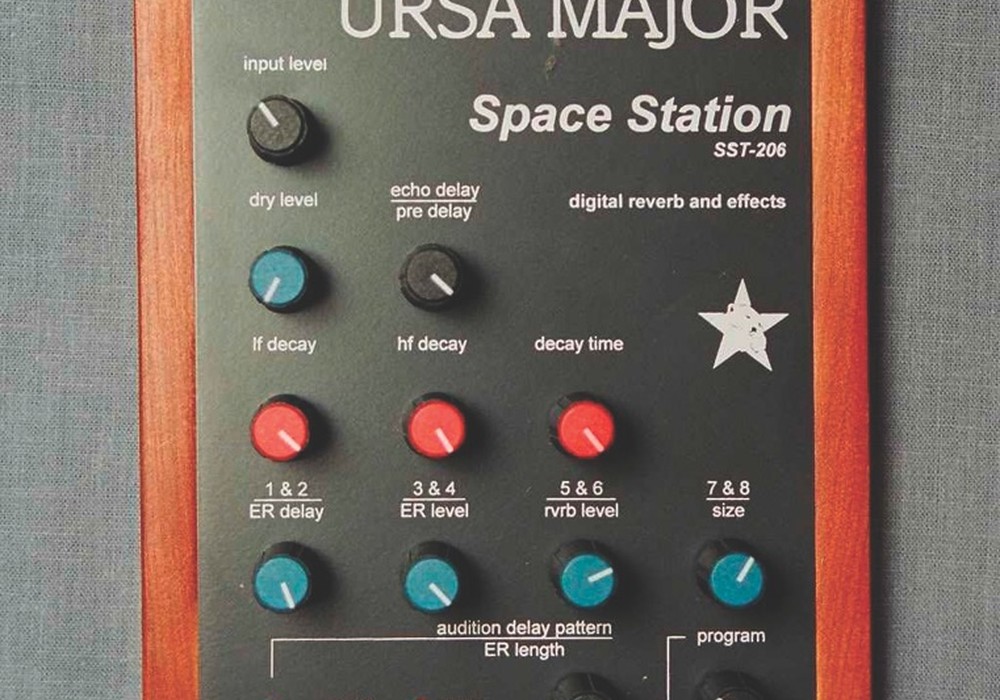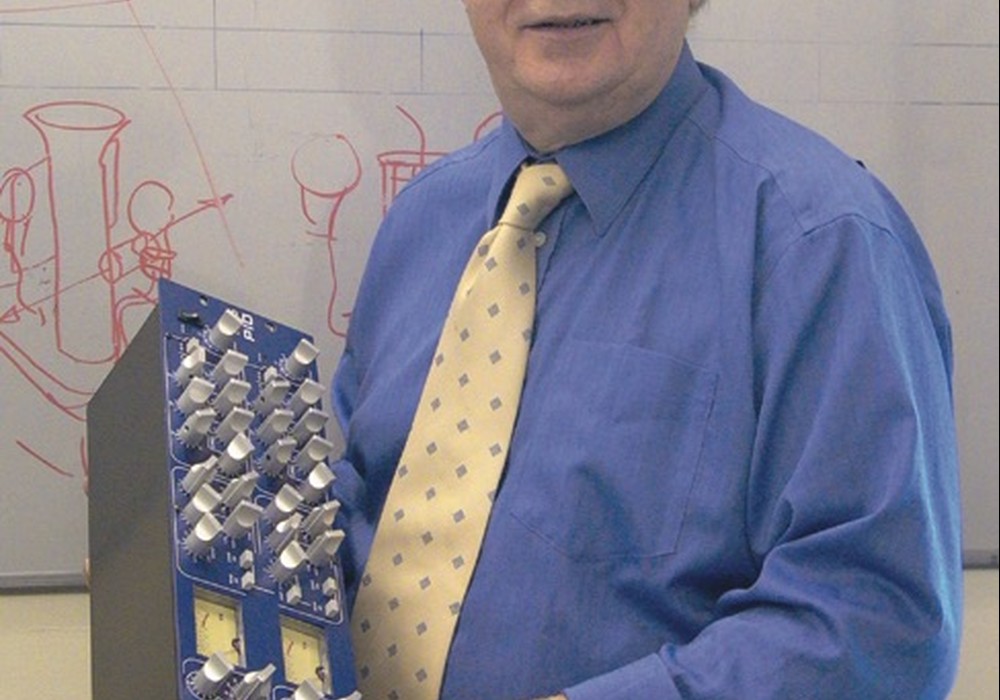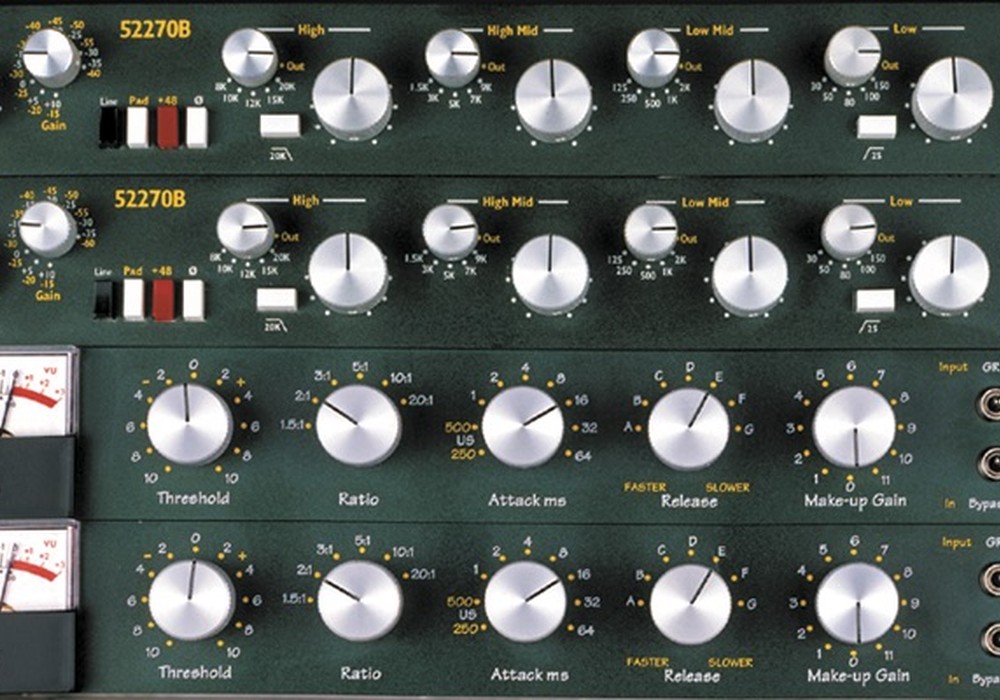Bob Moog, inventor of the legendary Moog synthesizers, is a friendly, down-to-earth man with a sharp wit and a sense of humor. He's practical, too — while interviewing him I moved his plate to make room for my mic stand on our table and he looked alarmed and said, "Wait! I'm going back for some cake!" Bob runs a beautiful little workshop in Asheville, North Carolina with a smallish crew of dedicated employees. What immediately impressed me was how they collectively ran their operation — I believe it is a model for others in the indigenous electronics business. They do finished assembly right there in a professional but friendly shop, and they can easily make sure everything that goes out the door is top quality. You can tell creativity thrives there — some employees made a theremin out of a pretzel barrel and it works! Bob drives a Toyota wagon that has been completely hand-painted with a mural by his young stepdaughter — very Moogy-Funky. A documentary about Bob and his machines, called simply Moog, is premiering in NY in September with a DVD out in the fall. Several MoogFests are taking place celebrating the Moog synthesizer, some even featuring The Album Leaf (see this issue). Visit www.moogmovie.com for more info!
How do you make things here at "Moog World Headquarters"?
We do final assembly and testing. We have the circuit boards made by those who specialize in that kind of work.
And somebody sends you wood panels and someone sends you metal chassis?
Exactly.
How did you end up in Asheville, NC?
The very first music teachers' convention I went to was the MTNA [Music Teachers National Association] conference in Dallas in 1965. By that time we had received quite a few orders for modular equipment, and I was beginning to find out the problem with not having special talents to get people to work for you. There I was exhibiting these funny modules to teachers who, by and large, didn't know what they were. Across the aisle from me was a fellow named George Kelischek. He had something called the Kelischek Workshop. George was a master violin maker who was making all sorts of authentic medieval and renaissance instruments. He was doing very well, playing his instruments, singing, and having a great time, and I looked at him and thought, 'There's a lucky guy.' So we started talking, and we became friends very quickly. He gave me some advice and hope. We kept up our friendship through the years, and in 1972 he invited my whole family and I to come down and visit him in western North Carolina. To live in his house, use his shop facilities and teach the children in his community a little about electronics — which I was always happy to do. So we came down all the way from Buffalo, we saw what a beautiful area it was, how nice the people were, and we decided when we could we would leave Buffalo and come to North Carolina and live here. I left Norlin Music (at that time the owner of Moog Music) and in June of 1978 we moved down here.
What about these crazy guitar pedals that you make? How many milliamps does that Mooger Fooger suck down? I bet you can't put a nine-volt battery in that.
No, you have to plug those in. What they are is little synthesizer modules.
Who came up with that name? Do you ever get in trouble for it?
I had a very good customer — one of the New York advertising music producers. His name is Edd Kalehoff. He had a production company somewhere in midtown Manhattan, and I went up to visit him once and he had just got[ten] a brand new mixing console in. Now, in that realm back then you had to look impressive in order to impress your clients. So he had this HUGE console — it must have been fifteen feet — and right in the middle he had a little sign made that read "MOOGER FOOGER". And I looked at that, and I laughed, and I said, "Someday I'm going to use that."
Tell me about the Piano Bar.
The Piano Bar is a development of Don Buchla. For the last 20 years at least Don has specialized in really novel musician-oriented control devices. One is called Thunder, one is called Lightning — it senses the position of your hands in two-dimensional space. Another one is The Marimba Lumina — it looks superficially like a marimba. They all have really deep, carefully crafted relationships built into the interface. He's really good at it — he may be the best in the world. So just a year ago, at the last NAMM, 2003, Don came walking through the show with this gun case. He opened it up and had the Piano Bar. It just blew my mind. What a great idea. I told Mike [Adams] about it. Mike knew if I liked it, it had some technical and musical merit. And Mike liked it because it made some business sense. There were a lot of people who had pianos and this would be a very nice thing for them to expand their capabilities. It sits on the cheek blocks on either side of the keyboard. It doesn't affect the keys. For anybody who has a piano and uses it for recording — this thing is absolutely open-ended. There are all kinds of things you can explore.
How come it isn't called a Buchla Piano Bar?
Because Don doesn't have that kind of an ego. We've been approached by people who say, "I'd like you to buy this design from me and you'll have put my name on it." We won't go into names, but we're dealing with that sort of thing right now. Don understands that if he makes something and he sells it — it makes sense to put Buchla on it. But if we're going to be selling it through our dealers, it makes sense to put the name Moog on it. It's a product of the Moog Company. But anybody who asks, I'll be glad to assure them that it was Don Buchla who designed it. When I began, in the sixties, it was David Tudor, Gordon Mumma and Don Buchla. David Tudor worked with John Cage. He used to do all his pieces with little shit that he would buy at Radio Shack and make it sound worse. But they had a sound. Gordon was a real innovator in the sixties. Now he's in California. They were the people I worked with. I learned from them. They opened my ears. All of them.
How did you come across these people? Were you kinda square, or were you always searching for weird stuff?
Everybody was square back in the fifties. You were either square or a freak. From my perspective, they [experimental musicians] were looking for us. I was an engineer — I could design electronic equipment that musicians were looking for. I was willing to work with musicians. That's how I began. I went to an experimental music concert. I was turned on by the guy's music, (it was Herb Deutsch), and next thing you know we were working together building stuff.
You met Walter Sear somewhere around this time.
I talked to him yesterday. I think Walter must have found out that I was making theremins, and contacted me, and became our representative in New York. This was before the synthesizer. I'm sure there were no contracts. There may have been a couple of letters. It was one of the newer Rockefeller Center buildings — he had a walk-up loft on the third or fourth floor where he did his tubas and he also played in the pit on Broadway shows. We're talking late fifties, early sixties. He was a composer, too — a conventional composer. He actually won a big prize for one of his string quartets. Walter Sear is not what you would call an electronic musician. He's not at all crazy musically. He handled our theremins and then he began selling modular synths to people on Madison Avenue. He did one hell of a job. He sold dozens of systems to music producers. I think more that any other one thing it was the people who make music for radio and television advertising who got the sound of the synthesizer into the public's ears. So when Switched On Bach came out, people had already heard them. They were not completely new. The way [Wendy] Carlos used them they reached a new plateau. Before that they were just cutesy sounds that were used in commercials.
What was the first sign that you were breaking through?
You know, things were moving erratically and rapidly all through the sixties. Well, in 1964 at the Audio Engineering Society I had this little exhibit on a card table, and people came by and placed orders. I didn't know how to run a business then. It was not much more than a hobby. Here were people wanting to buy this stuff. There were some pretty big names. The first guy to place an order was Alwin Nikolais, who, at the time, was a very well known experimental choreographer and dance music composer. Then [Vladimir] Ussachevsky and the Columbia Princeton Electronic Music Center placed an order. The second person to place an order was Eric Siday. He was not very visible to the general public but his music was extremely well known because he was the most successful of the early television and radio producers who used electronics. It was like a dream and a nightmare. I didn't know what the hell I was doing. Here I am — a graduate student at Cornell. I go to an experimental music Concert by Herb Deutsch — this is 1964 now. We work together — we have something that blows both of our minds. We get in the car and we drive up to Toronto where there is an experimental music studio and Myron Schaeffer and his crew get excited too. One of them calls up the AES and says, "Here is a guy doing something interesting." And that person calls me up August or September and says, "We hear you people are doing interesting things there — would you like to have an exhibit? It won't cost you anything." And all this is happening in a very short period of time. I show up alone. I'm giving a paper — the first paper I ever gave in my life to an engineering society. I have on a gray flannel suit. And I can remember my face turning as gray as my suit. I really still am a naïve kid. I was married then — had two kids, but still my experience was as a graduate student. And here I was taking orders for thousands of dollars of stuff. It was exhilarating and disorienting.
Did you think it would last as long as it did?
I had no idea.
Did you think about those kinds of things?
Looking back, I cannot remember what I was thinking. I am here to guarantee you that I never sat down and thought, 'Well, now I am going to think through the next fifty years and see how it is going to come out.' Just the opposite. I didn't do any sky gazing.
On some level you had to be watching others in the field.
I began to hear about Don Buchla. He was the competition. I didn't know exactly what kind of a guy he was or what he was doing but I saw a picture or two of him. Today Don and I are friends. We are certainly amiable colleagues. But back then we were suspicious of each other because we did not understand each other. Don was way ahead of me when it came to understanding experimental music. I was learning that on the job. It was a six-hour bus ride into New York City. It wasn't too much for me to get on the bus at midnight and at 6:20 am the Greyhound would pull into the Port Authority. And all sorts of wild stuff was going on there.
Can you characterize the way things were back then? What was assumed?
Eric Siday was already in his fifties. He was a trained musician. He had developed techniques for producing a sound electronically, for modifying it, and then for recording it. He had an experimental 8-track, 35 mm, full coat recorder and was one of the few people in the world that had such a thing. He lived with his wife who was an ex-blues singer from Boston. They were childless and they lived in an elegant ten-room apartment in New York [with a] big courtyard. Each apartment was a corner — four apartments on a floor. But — the living room was completely filled with microphones and percussion instruments. The dining room was filled mostly with papers. You walked in the kitchen and on the kitchen counter there were office machines and piles of bills and receipts. There was a grand entrance hall but it was completely filled with one of those big EMT reverb plates. There was a maid's room — but it had the tape recorders in it. There was a maid's bathroom — but most of it was used for tape storage. So the only place in this whole ten-room apartment that didn't have any gear in it was the bedroom. Everything else was completely filled with electronic stuff. I drove a whole Moog system into New York City and up the elevator to the tenth floor. After traveling all night. [The unit] was packed in hand made cartons. We had worked nine months on this thing — it was way overdue. Knock on the door, Eric answers, big smile on his face, and his wife is in back of him. We bring these things into the entrance hall, and I start unpacking the first one. I had loose papers in there as packing materials — it was all very amateurish. I finally got it all unpacked and here's this rack of modules. I began unpacking the second crate — Edith loses it. She's watching all this — she loses it. And she screams at the top of her lungs: "Eric! More SHIT in this house?! All you ever do is bring SHIT in this house! One piece of SHIT after the other!" She just collapses into a blubbering mass of tears, and Eric has to calm her, and here I am with a crowbar opening the second crate...
You're like this bastard home wrecker!
Yeah! Right! All she wanted out of life, as it turns out, was a station wagon and a house in the suburbs and a couple of kids. What does she have? This workshop on the tenth floor.
Did he do notable work with the gear you made for him?
It didn't hurt our business at all. It came out in Time or Newsweek in 1965 where they mention that he got paid $25,000 for a five-second sound logo. He already was top dog. And he knew that this [modular synth] was going to keep him there.
Now Moog was having its fits and starts — and at this point you're improvising your business.
The business side of it was totally out of control. We grew very fast on no capital to speak of. Nobody invested anything. The bank, on the other hand, loaned us a lot of money. I can tell you that's not the same thing. Fortunately we had no idea where it would go. I had no business sense. I was always a bit slow in that sense. The business itself never made that much money. When the crunch came in 1970, it was a three- pointed crunch. The market was saturated, there was a recession, and we had competition — ARP [Alan R. Pearlman]. Those people knew how to be businessmen. They knew how to market stuff.
You've managed to be around interesting people and you still have an office and a work place with good people. A new day — some new projects to try.
Yes, that I've always managed to do. For sure I am very fortunate. To be able to associate with all these great musicians. Crazy in a very positive way.
You had some interesting employees, too. Can you talk about Roger Luther? He has a great Moog Archive website.
I sold my controlling interest in the business in 1971. The guy I sold it to moved up to Buffalo, and that's where we remained until I left the company finally. And very soon after that this Volkswagen bus pulls up with Roger and Kathy Luther inside, two young musicians who had just graduated from some Midwestern conservatory. Roger had been offered a job at ARP, our competitor. They put everything they owned into their Volkswagen bus and drove to Boston to claim this job. When they got there, Roger found that the guy who hired him had himself been fired, and that there was no job for him at all. So they said, "Well, what are we going to do? Let's stop by the Moog plant on the way back." So they stopped by, Roger went to work sweeping the floor, Kathy went to work doing office assistant work. To make a long story short, Roger became plant manager — this is a musician, for Christ's sake — and he is now the plant manager of an electronics assembly operation in central New York State.
Speaking of archives — do you ever find yourself surrounded by crap? And you want to start throwing it?
Oh, all the time! I'd like nothing better than to be some kind of cerebral software developer. Just ideas.
There's something beloved with hardware, though. For one thing, you can smell it.
Yeah. And you can feel it. You can make a connection. But while you are making it, it's a pain in the ass! All this undifferentiated material.
What can you tell me about your recording studio in Trumansburg?
It could be used to perform electronic music composition. It wasn't a recording studio in a sense that we had microphones, a piano and drums and things. The main thing — we had a big synthesizer, and a 4-track and 2- track recorder, professional Scullys, and a couple of good speakers. Later on we had an 8-track recorder that we were experimenting with. And that was it. This studio was set up as a demonstration and teaching studio to do experiments on. We had a complete modular system — which we were always fooling with. And a little mixing board we built ourselves, but [it] was still very high quality. You could do professional work there if that was what you wanted to do. As it turns out, a lot of interesting stuff was done there. Nothing that became world famous or anything. Chris Swanson lived in Trumansburg and worked in that studio for several years and he did two albums. They were more or less distributed privately .He was the first one to use (it may sound disparaging to say this) "Switched On" techniques to do swinging, jazzy music. Chris used to be with Maynard Ferguson, Stan Kenton and Herb Palmeroy. In fact, the recordings Chris put together were professional quality — they still stand up. I still like listening to that work. We had an Antioch work study student, Jon Weiss, with us and he just stayed. He was an extremely gifted musician. His job was to demonstrate the equipment and teach people how to use it when they came. Jon never put out any recordings but he did several compositions on tape, which are amazing. One day we get a call from the music production community in New York. RCA was putting a record together and they wanted to put some synthesizer tracks on it. This turned out to be an album called Moog España, which came out in 1969. First thing RCA did — 8-track recorders were such rare things in 1968 — was [to] put one of their 1" 8-track recorders on a pickup truck and drive it 260 miles up to Trumansburg. Next day, the producers come. Sid Bass and Andy Wiswell. They had it all scored out by hand. No Coda. They came up with these 8-track tapes, six of which already had orchestral parts on it — horns and strings — you know, the real thing. It was Jon's job to give these guys what they wanted. As it turns out, it drove him nuts. Let's just say they were coming from a different place in the personalities. Sid Bass got out his cigar and yelled, "Give me some Oompha here!" Jon was one step above a tape op. A couple of times he came out and said, "I can't take this anymore. That's it. I'm sorry."
Were you encouraging him?
Well, he had an obligation because we made an agreement. I didn't think his reaction was going to be that strong. I guess if he had absolutely efused, I would have gone in — but it wouldn't have been as good. A couple of guys came from an advertising agency. They were putting together a station ID package. All the sounds. That was a lot of fun. Those guys had a sense of humor. I worked with them on that and somewhere I have a recording of that package. They're deeply in storage about 20 miles from here.
Can you talk about Wendy Carlos?
Well sure! Wendy was a student of Ussachevsky's when I first met her. She was very interested in what I was doing, as was Ussachevsky. She finished her studies at the Columbia/Princeton Electronic Music Center. Got a job as a recording engineer with Gotham Recording in New York City. She began to order modules a few at a time. I visited Ussachevsky and we all met at a Chinese restaurant near the university.
You did so much with so little. It was a tiny enclave of people, wasn't it?
You needed a tape recorder to do electronic music and there weren't that many people who had them. Back then a tape recorder was something pretty exotic. And if you had a "professional" tape recorder... [whistles] Then you were close to being unique. Wendy had her circle of friends. There were two people — Benjamin Folkman, who was very good musician, and Rachel Elkin, who was a woman of considerable intelligence, who was the executive secretary for Goddard Lieberson, who was one of the real higher-ups at Columbia Records. The three of them sort of conceived of Switched On Bach together. It was Wendy's talent that brought it to fruition. But the three of them were involved in the conceptualization of the project.
I consider Wendy a watershed person because she was both an excellent engineer and a visionary performer.
Yeah. And she has a God-given talent for doing what she does. Which puts her right at the top. You can't leave that part of it out.
What do you think about modern music and performance?
I build stuff for people who want to play the stuff I build. I know that's not all the musicians in the world, and I really don't have much contact with other musicians. I'm not in the music business — I'm in the musical instrument business. Historically, every era in human history has had its primary technology where all the new things are being done. The musical instruments that were developed in that era invariably use that technology. The technology of our time is electronics and computers.
Yet now there is a "harking back", if you will, via computers, to the early analog synth sounds.
Well, sometimes old stuff sounds better than new stuff. I don't think it's very complicated. Just because it's new doesn't mean it sounds good. Or better.


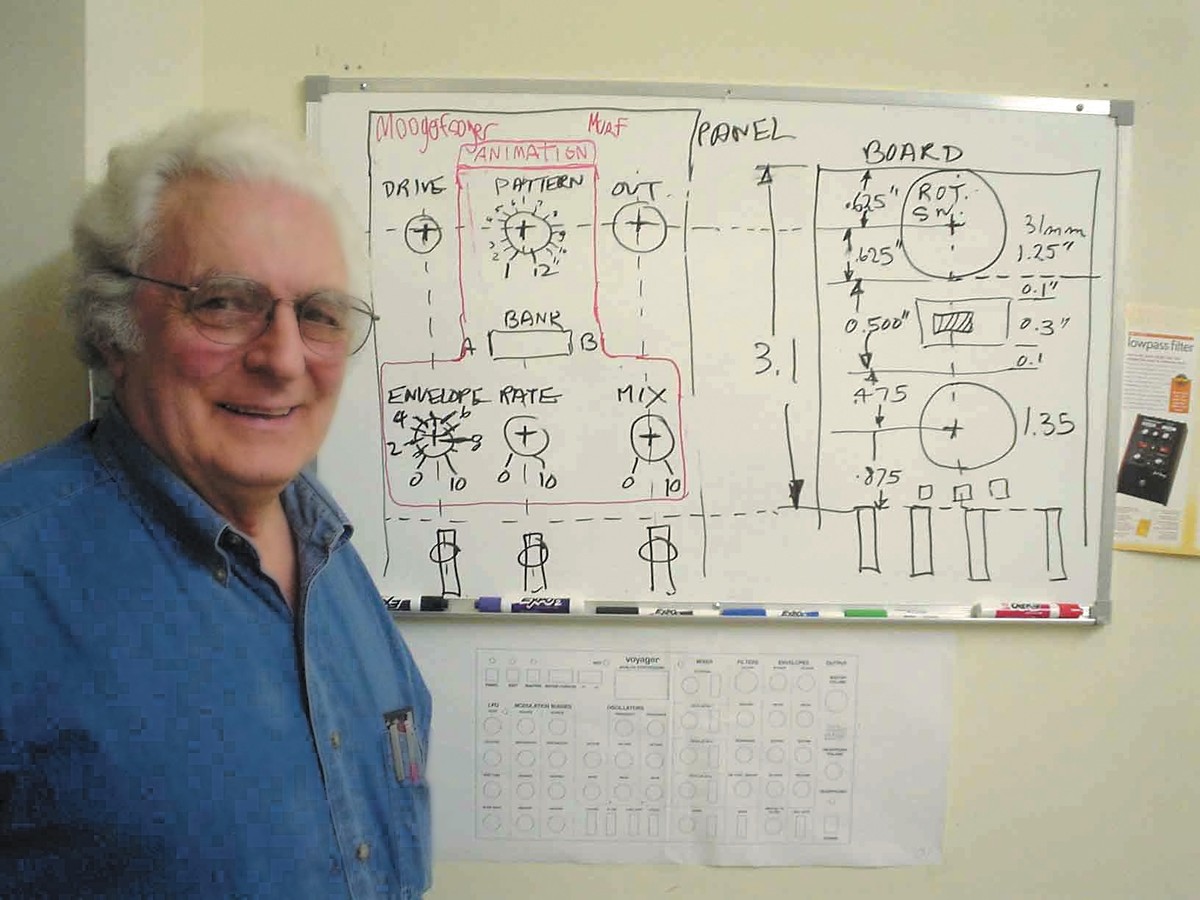
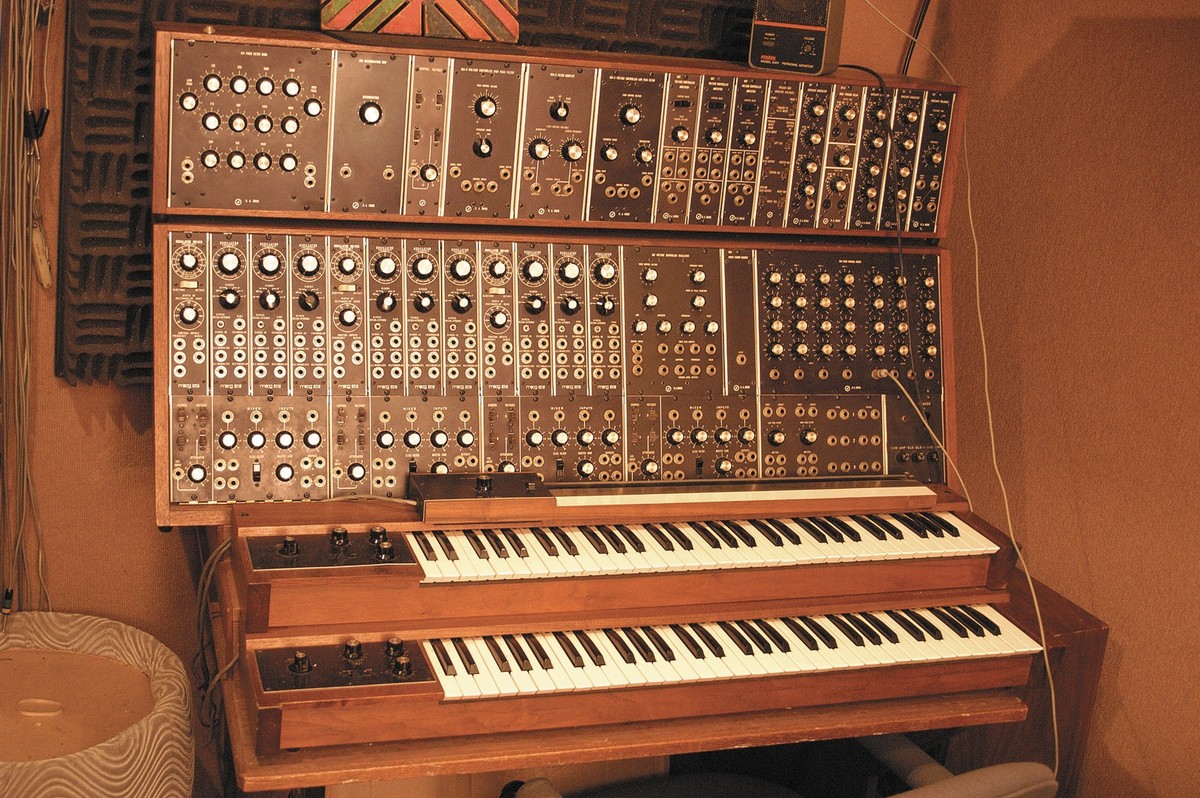


_disp_horizontal_bw.jpg)
